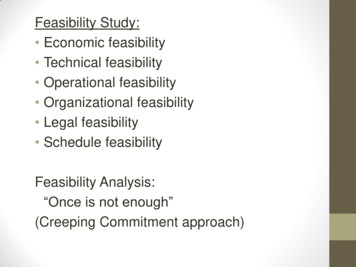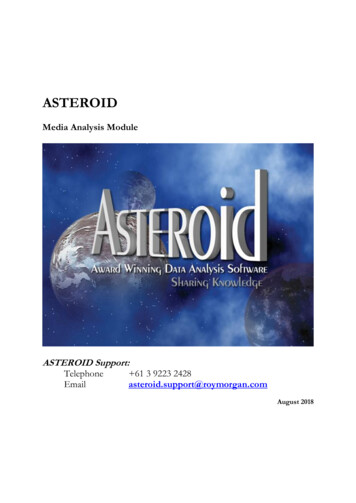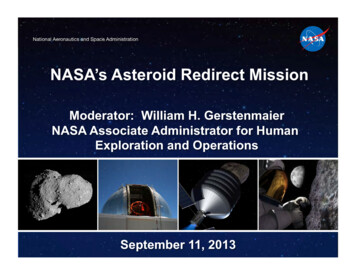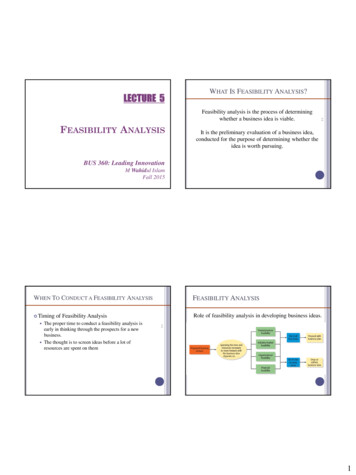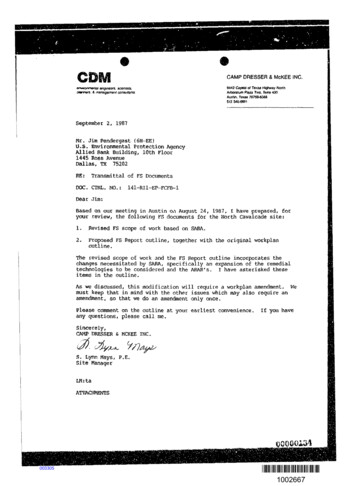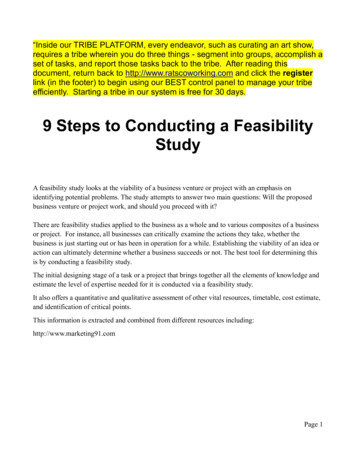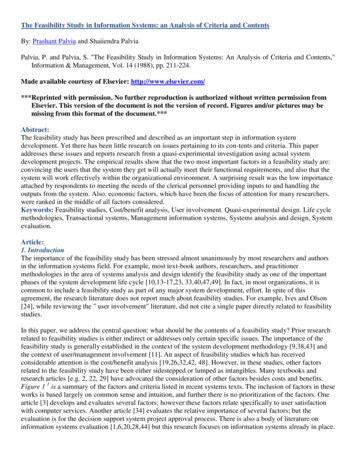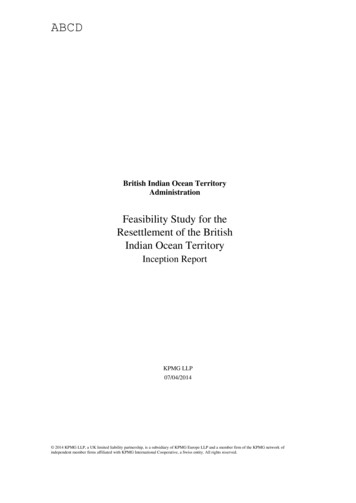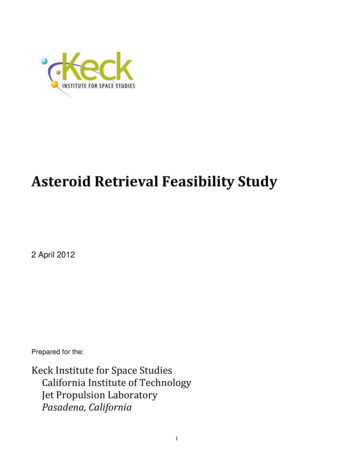
Transcription
Asteroid Retrieval Feasibility Study2 April 2012Prepared for the:Keck Institute for Space StudiesCalifornia Institute of TechnologyJet Propulsion LaboratoryPasadena, California1
2
Authors and Study ParticipantsNAMEJohn BrophyOrganizationCo-Leader / NASA JPL / CaltechE-Mailjohn.r.brophy@jpl.nasa.govFred CulickCo-Leader / CaltechCo-Leader / The PlanetarySocietyNASA JSCfecfly@caltech.edudavidcbaughman@me.comBruce BettsNaval Postgraduate SchoolNASA ARC/Carnegie MellonUniversityThe Planetary SocietyMike BrownCaltechmbrown@caltech.eduMichael BuschUCLAmbusch@ess.ucla.eduJohn CasaniNASA JPLJohn.R.Casani@jpl.nasa.govMarcello CoradiniESAMarcello.Coradini@jpl.nasa.govJohn DankanichNASA GRCJohn.Dankanich@nasa.govPaul DimotakisCaltechHarvard-Smithsonian Center bert.Gershman@jpl.nasa.govDamon LandauNASA JPLFlorida Institute for Human andMachine CognitionNASA JPLChris LewickiArkyd Astronauticschris@arkyd.comJohn LewisUniversity of Arizonajsl@U.Arizona.eduPedro LlanosUSCllanos@usc.eduMark LupisellaNASA GSFCmark.l.lupisella@nasa.govDan MazanekNASA LaRCDaniel.D.Mazanek@nasa.govPrakhar MehrotraCaltechprakhar@caltech.eduJoe usty SchweickartNASA GSFCNASA ARC/Carnegie MellonUniversityB612 FoundationGuru SinghNASA JPLgurkirpal.singh@jpl.nasa.govNathan StrangeNASA JPLNathan.J.Strange@jpl.nasa.govMarco TantardiniThe Planetary Societymarco.tantardini@gmail.comBrian WilcoxNASA JPLBrian.H.Wilcox@jpl.nasa.govColin WilliamsNASA JPLColin.P.Williams@jpl.nasa.govWillie WilliamsNASA JSCWillie.B.Williams@nasa.govDon YeomansNASA JPLDonald.K.Yeomans@jpl.nasa.govLouis FriedmanCarlton AllenDavid BaughmanJulie BelleroseMartin ElvisIan Garrick-BethelBob GershmanTom JonesKevin com3Signature
Table of ContentsPageExecutive Summary 5I.Introduction . 7Why Now?. 8II. Rationale and Benefits . 9Synergy with Near-Term Human Exploration .9Expansion of International Cooperation in Space . 10Synergy with Planetary Defense 11Exploitation of Asteroid Resources . 12Public Engagement . 13III. Mission Overview & Safety Considerations 14Final Destination 15Safety 15IV. Target Discovery and Characterization 16Asteroid Type . 16Discovery and Characterization Techniques . 16Observation Campaign 19Alternative Approach 21V. Flight System Design . 22Electric Propulsion (EP) Subsystem . 22Reaction Control Subsystem (RCS) . 24Electrical Power Subsystem (EPS) 24Communications Subsystem . 25Master Equipment List (MEL) . 25Alternative Flight System Architecture . 26Capture Mechanism . 27VI. Mission Design . 28Earth Departure, Rendezvous and Pre-Capture Operations 28Pick Up a Rock Alternative Mission Approach . 30Get a Whole One Pre-Capture Operations 31Capture and Post-Capture Operations 32Getting to Lunar Orbit 36Cislunar Operations . 37Cost Estimate . 39VII. SEP Technology and Required Development 41Solar Array Technology . 42Electric Propulsion Technology 43Near-Term Application of SEP Technology for Human Missions to NEAs . 43VIII. Recommended Near-Term Follow-on Activities 46Observation Campaign . 46Mission Design . 46Capture Mechanism Development . 46SEP Subsystem PPU Development 46IX. Conclusions . 47Acknowledgements 48References 494
EXECUTIVE SUMMARYThis report describes the results of a study sponsored by the Keck Institute for Space Studies (KISS)to investigate the feasibility of identifying, robotically capturing, and returning an entire Near-EarthAsteroid (NEA) to the vicinity of the Earth by the middle of the next decade. The KISS study wasperformed by people from Ames Research Center, Glenn Research Center, Goddard Space FlightCenter, Jet Propulsion Laboratory, Johnson Space Center, Langley Research Center, the CaliforniaInstitute of Technology, Carnegie Mellon, Harvard University, the Naval Postgraduate School,University of California at Los Angeles, University of California at Santa Cruz, University of SouthernCalifornia, Arkyd Astronautics, Inc., The Planetary Society, the B612 Foundation, and the FloridaInstitute for Human and Machine Cognition. The feasibility of an asteroid retrieval mission hinges onfinding an overlap between the smallest NEAs that could be reasonably discovered and characterizedand the largest NEAs that could be captured and transported in a reasonable flight time. This overlapappears to be centered on NEAs roughly 7 m in diameter corresponding to masses in the range of250,000 kg to 1,000,000 kg. To put this in perspective, the Apollo program returned 382 kg of Moonrocks in six missions and the OSIRIS-REx mission proposes to return at least 60 grams of surfacematerial from a NEA by 2023. The present study indicates that it would be possible to return a 500,000-kg NEA to high lunar orbit by around 2025.Illustration of an asteroid retrieval spacecraft in the process of capturing a 7-m, 500-ton asteroid.(Image Credit: Rick Sternbach / KISS)5
The idea of exploiting the natural resources of asteroids dates back over a hundred years, but onlynow has the technology become available to make this idea a reality. The feasibility is enabled by threekey developments: the ability to discover and characterize an adequate number of sufficiently smallnear-Earth asteroids for capture and return; the ability to implement sufficiently powerful solar electricpropulsion systems to enable transportation of the captured NEA; and the proposed human presence incislunar space in the 2020s enabling exploration and exploitation of the returned NEA.Placing a 500-t asteroid in high lunar orbit would provide a unique, meaningful, and affordabledestination for astronaut crews in the next decade. This disruptive capability would have a positiveimpact on a wide range of the nation’s human space exploration interests. It would provide a high-valuetarget in cislunar space that would require a human presence to take full advantage of this new resource.It would offer an affordable path to providing operational experience with astronauts working aroundand with a NEA that could feed forward to much longer duration human missions to larger NEAs indeep space. It would provide an affordable path to meeting the nation’s goal of sending astronauts to anear-Earth object by 2025. It represents a new synergy between robotic and human missions in whichrobotic spacecraft retrieve significant quantities of valuable resources for exploitation by astronaut crewsto enable human exploration farther out into the solar system. A key example of this is that water orother material extracted from a returned, volatile-rich NEA could be used to provide affordableshielding against galactic cosmic rays. The extracted water could also be used for propellant to transportthe shielded habitat. These activities could jump-start an entire in situ resource utilization (ISRU)industry. The availability of a multi-hundred-ton asteroid in lunar orbit could also stimulate theexpansion of international cooperation in space as agencies work together to determine how to sampleand process this raw material. The capture, transportation, examination, and dissection of an entire NEAwould provide valuable information for planetary defense activities that may someday have to deflect amuch larger near-Earth object. Finally, placing a NEA in lunar orbit would provide a new capability forhuman exploration not seen since Apollo. Such an achievement has the potential to inspire a nation. Itwould be mankind’s first attempt at modifying the heavens to enable the permanent settlement ofhumans in space.The report that follows outlines the observation campaign necessary to discover and characterizeNEAs with the right combination of physical and orbital characteristics that make them attractive targetsfor return. It suggests that with the right ground-based observation campaign approximately fiveattractive targets per year could be discovered and adequately characterized. The report also provides aconceptual design of a flight system with the capability to rendezvous with a NEA in deep space,perform in situ characterization of the object and subsequently capture it, de-spin it, and transport it tolunar orbit in a total flight time of 6 to 10 years. The transportation capability would be enabled by a 40-kW solar electric propulsion system with a specific impulse of 3,000 s. Significantly, the entireflight system could be launched to low-Earth orbit on a single Atlas V-class launch vehicle. With aninitial mass to low-Earth orbit (IMLEO) of 18,000 kg, the subsequent delivery of a 500-t asteroid tolunar orbit represents a mass amplification factor of about 28-to-1. That is, 28 times the mass launchedto LEO would be delivered to high lunar orbit, where it would be energetically in a favorable location tosupport human exploration beyond cislunar space. Longer flight times, higher power SEP systems, or atarget asteroid in a particularly favorable orbit could increase the mass amplification factor from 28-to-1to 70-to-1 or greater. The NASA GRC COMPASS team estimated the full life-cycle cost of an asteroidcapture and return mission at 2.6B.6
I.INTRODUCTIONThe idea to exploit the natural resources of asteroids is older than the space program. KonstantinTsiolkovskii included in The Exploration of Cosmic Space by Means of Reaction Motors, published in1903, the “exploitation of asteroids” as one of his fourteen points for the conquest of space [1]. Morerecently this idea was detailed in John Lewis’ book Mining the Sky [2], and it has long been a majortheme of science fiction stories [3]. The difference today is that the technology necessary to make this areality is just now becoming available. To test the validity of this assertion, NASA sponsored a smallstudy in 2010 to investigate the feasibility of identifying, robotically capturing, and returning to theInternational Space Station (ISS), an entire small near-Earth asteroid (NEA) – approximately 2-mdiameter with a mass of order 10,000 kg – by 2025 [4]. This NASA study concluded that whilechallenging there were no fundamental show-stoppers that would make such a mission impossible. Itwas clear from this study that one of the most challenging aspects of the mission was the identificationand characterization of target NEAs suitable for capture and return.In 2011 the Keck Institute for Space Studies (KISS) [5] sponsored a more in-depth investigation ofthe feasibility of returning an entire NEA to the vicinity of the Earth. The KISS study focused onreturning an asteroid to a high lunar orbit instead of a low-Earth orbit. This would have severaladvantages. Chief among these is that it would be easier from a propulsion standpoint to return anasteroid to a high lunar orbit rather than take it down much deeper into the Earth’s gravity well.Therefore, larger, heavier asteroids could be retrieved. Since larger asteroids are easier to discover andcharacterize this helps to mitigate one of the key feasibility issues, i.e., identifying target asteroids forreturn. The KISS study eventually settled on the evaluation of the feasibility of retrieving a 7-mdiameter asteroid with a mass of order 500,000 kg. To put this in perspective, the Apollo programreturned 382 kg of moon rocks in six missions. The OSIRIS-REx mission [6] proposes to return at least60 grams of surface material from a NEA by 2023. The Asteroid Capture and Return (ACR) mission,that is the focus of this KISS study, seeks return a 500,000-kg asteroid to a high lunar orbit by the year2025.The KISS study enlisted the expertise of people from around the nation including representativesfrom most of the NASA centers (ARC, GRC, GSFC, JPL, JSC, and LaRC), several universities(Caltech, Carnegie Mellon, Harvard, Naval Postgraduate School, UCLA, UCSC, and USC), as well asseveral private organizations (Arkyd Astronautics, Inc., The Planetary Society, B612 Foundation, andFlorida Institute for Human and Machine Cognition). The people listed below participated in the KISSstudy and developed the contents of this report. The study was conducted over a six-month periodbeginning with a four-day workshop in September 2011 followed by a two-day workshop in February2012, and concluding with the submission of this report in April 2012.John Brophy (Co-Leader / NASA JPL)Fred Culick (Co-Leader / Caltech)Louis Friedman (Co-Leader / The Planetary Society)Carlton Allen (NASA JSC)David Baughman (Naval Postgraduate School)Julie Bellerose (NASA ARC)Bruce Betts (The Planetary Society)Mike Brown (Caltech)Michael Busch (UCLA/NRAO)John Casani (NASA JPL)Marcello Coradini (ESA)John Dankanich (NASA GRC)Paul Dimotakis (Caltech)Martin Elvis (Harvard-Smithsonian Center for Astrophysics)7
Ian Garrick-Bethel (UCSC)Bob Gershman (NASA JPL)Tom Jones (Florida Institute for Human and Machine Cognition)Damon Landau (NASA JPL)Chris Lewicki (Arkyd Astronautics, Inc)John Lewis (University of Arizona)Pedro Llanos (USC)Mark Lupisella (NASA GSFC)Dan Mazanek (NASA LaRC)Prakhar Mehrotra (Caltech)Joe Nuth (NASA GSFC)Kevin Parkin (NASA ARC)Rusty Schweickart (B612 Foundation)Guru Singh (NASA JPL)Nathan Strange (NASA JPL)Marco Tantardini (The Planetary Society)Brian Wilcox (NASA JPL)Colin Williams (NASA JPL)Willie Williams (NASA JSC)Don Yeomans (NASA JPL)The KISS study consisted primarily of two workshops, the first held in September 2011 lasting for fourdays, and the second a two-day workshop in February 2012, with additional work performed betweenworkshops. The three main objectives of the KISS study were to:1. Determine the feasibility of robotically capturing and returning a small near-Earth asteroid to thevicinity of the Earth using technology available in this decade.2. Identify the benefits to NASA, the scientific community, the aerospace community, and the generalpublic of such an endeavor.3. Identify how this endeavor could impact NASA’s and the international space community’s plans forhuman exploration beyond low-Earth orbitA mission to retrieve an entire near-Earth asteroid must successfully address the following three keyfeasibility issues:1. How to discover and characterize a sufficient number of candidate asteroids to enable robust missionplanning for a launch around 2020?2. How to capture and de-spin an asteroid with a mass of order 500,000 kg in deep space?3. How to safely transport the captured 500,000-kg asteroid back to the Earth-Moon system and place itin a high lunar orbit?The feasibility of capturing and returning an entire NEA to a high lunar orbit, as well as the benefits toNASA and the nation are discussed in the sections below.Why Now?Given that the idea to exploit the natural resources of asteroids is very old, what has changed thatwarrants serious investigation into the feasibility of capturing and returning entire near-Earth asteroidsto the Earth-Moon system? The answer is, as mentioned in the opening paragraph above, that thetechnology necessary to make this possible is just now becoming available. There are three key enablingelements: 1) We now have ability to discover and characterize a sufficient number of sufficiently smallnear-Earth asteroids; 2) Sufficiently powerful solar electric propulsion systems necessary to transport acaptured NEA are also just now becoming available; and 3) NASA is planning to have an humanexploration capability in cislunar space in a time frame that is compatible with when an asteroid couldbe delivered to lunar orbit. Placing a 500-t asteroid there would provide a unique, meaningful, and easyto-reach destination for exploration by astronaut crews in the next decade.8
II.RATIONALE AND BENEFITSBefore discussing the feasibility of returning a 500 metric ton asteroid to lunar orbit, it is importantto identify why such an endeavor is important, what benefits it would provide to NASA, the nation, andthe international community, and why the public should care. Five general categories of benefits fromthe return of an entire NEA were identified: 1) Synergy with near-term human exploration; 2) Expansionof international cooperation in space; 3) Synergy with planetary defense; 4) Exploitation of asteroidresources to the benefit of human exploration beyond the Earth-moon system; and 5) Publicengagement.Synergy with Near-Term Human ExplorationThe Asteroid Capture-and-Return mission (ACR) concept fits well within the current humanspaceflight goals of NASA and its international partners. NASA is currently pursuing the goal ofsending an astronaut expedition to a near-Earth asteroid sometime around 2025. A number of keymilestones must be accomplished before that would be possible:a) A search for smaller, more numerous, and dynamically accessible NEA targets.b) Development of a deep-space crewed spacecraft and heavy-lift launch system.c) One or more robotic precursors designed to characterize the general properties of NEAs.d) A scout mission to the likely human target to enhance safety and enable detailed missionplanning.The ACR mission concept offers an affordable, intermediate performance goal that could maintainmomentum toward deep space expeditions and reduce programmatic risk. It would support human deepspace exploration in the following six ways:First, the ACR mission could partially fulfill the role of a robotic precursor, yet provide far moreinformation about asteroid structure, composition, and mechanical properties through the extensive fieldinvestigation it would enable. The mission would increase greatly our ability to perform complexscientific and flight operations around NEAs, well beyond levels contemplated by currently plannedrobotic missions. For example, the ACR mission would require mastery of autonomous proximityoperations around a small body, part of a skill set that is directly applicable to a wide variety of beyondLEO missions. A NEA retrieval mission – if conducted promptly – could feed experience and hardwareforward into plans for a series of human NEA expeditions in deep space. The risk reduction andhardware validation obtained via a retrieval mission would aid subsequent human exploration planning.This gain in capability would build confidence in and reduces the risk of the first human mission to aNEA.Second, by making available hundreds of tons of asteroidal material within the Earth-Moon system,ACR mission concept would enable astronaut visits that would take only a few weeks, not the half ayear or more required for even the most accessible NEA targets. Compared to a deep-space NEAmission, a “local” visit to the captured ACR object would enable the crew to spend a much higherfraction of their mission time actually working at the object. Such a “local asteroid” mission wouldclearly be a bridge between LEO operations and full-fledged deep-space NEA expeditions. The shorterduration would also reduce significantly the radiation hazard facing the crew.Third, the ACR mission concept would put bulk asteroidal material within reach of Earth-Moon L2(EM L2) facilities and transport systems, now being evaluated by NASA as a waypoint to lunar,asteroid, and Mars system destinations. Visits from the L2 outpost to this small captured asteroid wouldbe an attractive sortie option for astronaut crews, providing opportunities for sample return, in-depthscientific examination, and demonstration of resource processing methods. The ACR mission wouldenhance the scientific, operational, and economic value of establishing a human-tended outpost at EML2.9
Fourth, providing hundreds of tons of asteroidal material in cislunar space would open the door tolarge-scale use of extraterrestrial resources by NASA and its commercial partners. Extraction ofpropellants, bulk shielding, and life support fluids from this first captured asteroid could jump-start anentire space-based industry. Our space capabilities would finally have caught up with the speculativeattractions of using space resources in situ. One of the simplest but highly leveraged benefits from theseresources might be the provision of bulk shielding material for future deep-space expeditions—a simplebut effective countermeasure to galactic cosmic ray exposure.Fifth, the public would clearly see the results from human exploration once astronauts begin thelengthy, challenging task of examining and “dissecting” a 500 metric ton asteroid. This ongoingrobotic and astronaut operation would provide a steady stream of “real-time exploration” results to apublic attracted to the scientific unknowns and the economic potential of this captured asteroid.Eventually, commercial consortia should be given access to the object to test resource processingmethods and compete for resource production rights on this and other objects.Sixth, the development of a high-power (40-kW class) solar electric propulsion system wouldprovide a high-performance transportation capability that would benefit other human missions in deepspace through cargo delivery and hardware pre-deployment. It would also provide a stepping stone toeven higher power SEP vehicles that could be used directly for crew transportation to NEAs andbeyond.Taken together, these attributes of an ACR mission would endow NASA (and its partners) with anew demonstrated capability in deep space that hasn’t been seen since Apollo. Once astronaut visits tothe captured object begin, NASA would be putting human explorers in contact with an ancient,scientifically intriguing, and economically valuable body beyond the Moon, an achievement that wouldcompare very favorably to any attempts to repeat the Apollo lunar landings.Expansion of International Cooperation in SpaceThe retrieval of a several-hundred-ton carbonaceous asteroid would present unparalleledopportunities for international cooperation. The retrieval could be carried out under the samephilosophy as the Apollo program, “in peace for all mankind,” but with a significant advantage. Aninternational panel could be formed to oversee both curation of the body and the review of proposals forits study. The demand for samples for engineering and scientific study of the carbonaceous chondritematerial by academic, governmental, and industrial laboratories – usually severely hampered by lack ofpristine material – could be met generously. Samples could be returned to Earth for study, whereasmicrogravity processing experiments of the sort envisioned above could be carried out in situ in itsparking orbit. Selected spacefaring nations would have access to the body under the oversight of theinternational curatorial panel. Nations without the ability to fly missions to the body would beencouraged to form teaming arrangements and propose jointly with those who can access it.As a natural step in moving human exploration capabilities from the International Space Station(ISS) into cislunar space, then beyond, the ACR mission concept would offer many opportunities forinternational participation.1. Our current knowledge of the composition and surface properties of asteroids results from aninternational scientific exploration effort, including probes from NASA, JAXA, and ESA (e.g.NEAR-Shoemaker, Dawn, Hayabusa, and Rosetta). The U.S. and Japan have flown spacecraft torendezvous with Near-Earth Object (NEOs), and Japan has returned samples from near-Earthasteroid 25143 Itokawa. Following up on the ESA Don Quijote study, the European Union has nowfunded an international consortium for a planetary defense study to organize, prepare and implementmitigation measures. Skills gained from all of these encounters might be combined to furnish thespacecraft and scientific instrument complement for the proposed ACR mission. Examples ofcontributed hardware to the ACR mission could include: launch systems, orbit transfer stages, solar10
arrays, ion thrusters, remote sensing and imaging instruments, asteroid capture and retentionsystems, communications avionics and antennae, and docking hardware for future astronaut visits.2. Once the target asteroid arrives in cislunar space, the mission partners could open the many tons ofasteroid mass to international sampling, study, and economic assay, extending the collaboration overmany years. Follow-up scientific and processing visits to the returned NEA could be a collaborativeeffort, combining partner investigations and hardware to assess the nature of the object and thenbegin its industrial processing. The attraction of such an intriguing object in cislunar space wouldlikely draw new partners and serve to expand today’s ISS coalition.3. The proposed ACR mission concept would lend itself also to the developing international frameworkfor planetary defense from a NEO impact. Space agencies meeting under the auspices of the UnitedNations Committee on the Peaceful Uses of Outer Space are discussing the planning and operationsrequired for an international mission demonstrating the techniques that would be required to deflecta hazardous asteroid. [7,8] In addition, the NASA Advisory Council’s ad hoc Task Force onPlanetary Defense recommended in 2010 that NASA pursue leadership of an international deflectionmission as its long-term planetary defense objective [9]. Because the proposed ACR mission would,by definition, be a safe “deflection” of a non-hazardous asteroid, the mission concept would fit verywell into this multinational effort, one that would also offer numerous scientific and humanexploration benefits.4. Russia, Europe, and Japan are all evaluating future human spaceflight systems, first to reach andservice the ISS, but with application to deep-space transport. NASA’s ISS partners wish to build ontheir Space Station achievements by participating in future deep-space expeditions. If the proposedACR mission made available tons of asteroidal material in cislunar space, it would spurcollaborative efforts to access this new natural satellite. Experience gained via human expeditions tothe small returned NEA would transfer directly to follow-on international expeditions beyond theEarth-Moon system: to other near-Earth asteroids, Phobos and Deimos, Mars and potentiallysomeday to the main asteroid belt.Synergy with Planetary DefenseAn asteroid return mission would bring broader attention to the subject of near-Earth asteroids andtherefore greater understanding and attention to the planetary defense challenge element of NEOs.From a technical standpoint an asteroid return mission would enable significant progress in thefollowing areas relative to planetary defense:1. Anchoring. Many options for more efficient and capable deflection of NEOs would open up if wedevelop reliable robotic anchoring capability. The latest time to act prior to impact could besignificantly delayed if robust techniques are available. Anchoring is the key to enable many ofthem.2. Structural characterization, especially of the surface layers. Kinetic impact is today one of the primedeflection technologies available. Yet its effectiveness is highly uncertain due to the (so called)momentum multiplier (beta) variability. Ejecta (at greater than escape velocity) from a kineticimpact may multiply the impactor momentum transferred to the NEO by a factor from 2-10 or more.Structural characterization of the surface layers may reduce this uncertainty to a factor of 2 or less.3. Dust environment. The dust environment is expected to be highly variable and object dependent.Nevertheless, understanding the forces triggering dust levitation and settling behavior are importantfor the gravity tractor (GT) concept in which SEP exhaust impingement on the asteroid could create11
a dust hazard. As a minimum greater knowledge here would enable more efficient system designsand a better understanding of stand-off requirements.4. Proximity operations. Techniques for proximity operations and NEO navigation gained fromreturning an asteroid would be directly transferable to planetary defense planning andimplementation.Exploitation of Asteroid ResourcesFrom a long-term architectural point of view, the ability to test resource extraction processes andenable commercial resource production ideas to be applied to the captured NEA would pave the way foruse of asteroidal materials in human deep-space expeditions, greatly reducing required up-mass fromEarth, and thus the cost, of such missions. A 500-t, carbonaceous C-type asteroid may contain up to200 t of volatiles ( 100 t water and 100 t carbon-rich compounds), 90 t of metals (approximately 83 tof iron, 6 t of nickel, and 1 t of cobalt), and 200 t of silicate residue (similar to the average lunar surfacematerial). As discussed below, the ACR mission concept baselines a single Atlas V 551-class launch,with an initial mass to low-Earth orbit (IMLEO) of 18,000 kg. The delivery of a 500-t asteroid to lunarorbit, therefore, represents a mass amplification factor of about 28-to-1. That is, whatever mass islaunched to LEO, 28 times that mass wo
theme of science fiction stories [3]. The difference today is that the technology necessary to make this a reality is just now becoming available. To test the validity of this assertion, NASA sponsored a small study in 2010 to investigate the feasibility of identifying, robotically capturing, and returning to the
